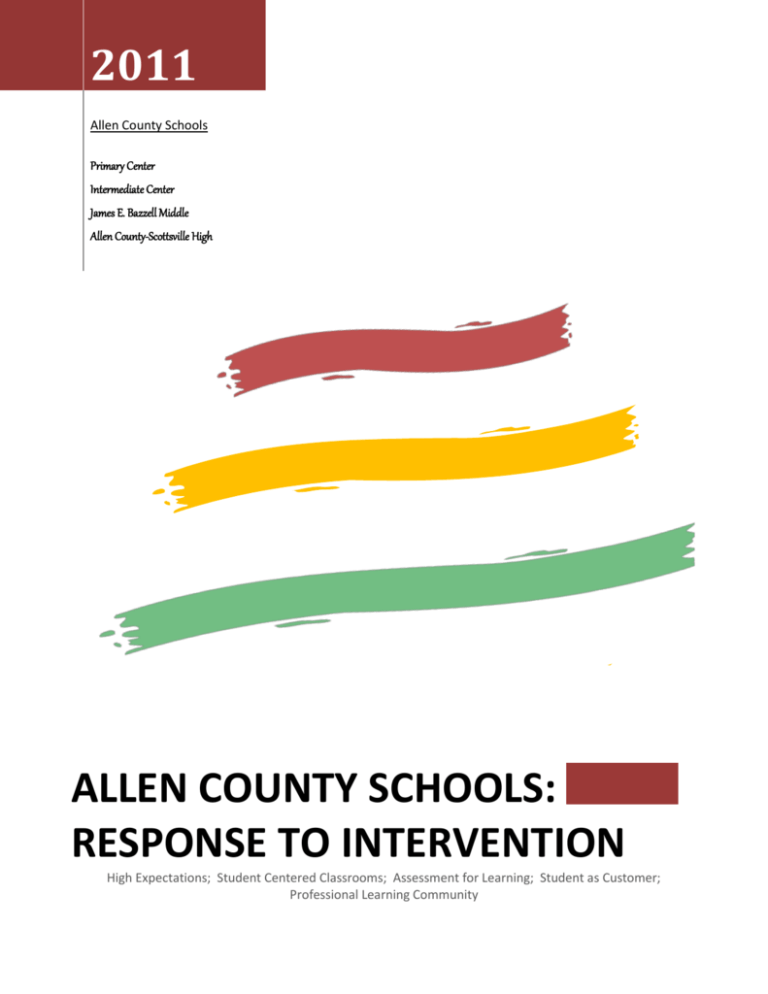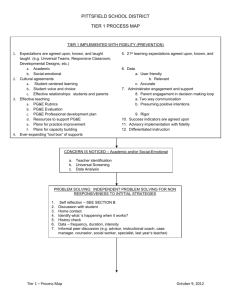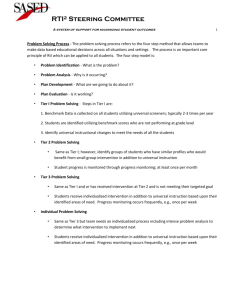District RTI Plan - Allen County Schools
advertisement

2011 Allen County Schools Primary Center Intermediate Center James E. Bazzell Middle Allen County-Scottsville High ALLEN COUNTY SCHOOLS: RESPONSE TO INTERVENTION High Expectations; Student Centered Classrooms; Assessment for Learning; Student as Customer; Professional Learning Community ALLEN COUNTY SCHOOLS: RESPONSE TO INTERVENTION “I have often told people when I first heard about RTI, I read three books on the topic and I was more confused than ever. I attended two big conferences on RTI and I still had no idea what I was supposed to do differently in my classroom! And this is the experience I hear from teachers around the country; that the more professional development they get on RTI, the more confused, the more scared, the more underequipped they feel to implement Response to Intervention”. Pat Quinn The purpose of this document is to make simple the process of RTI. Teacher tasks are in red print for easier interpretation of what is to be done in each stage. First, you must decide on the structure of your RTI team(s). They may be interdisciplinary teams or departments or other. The function of the team is to monitor the progress of students identified as needing extra help. The team should meet at least once per ten days of instruction to discuss the progress of the identified students. Stage 1: Universal Screening The universal screening is given to all students at the beginning of the year and up to two additional times during the year. Review the results for your particular students and note any concerns. Each school has a plan in place to give these screeners so you the teacher have only the job of reviewing the results and looking for potential areas of need. Students identified as being severely behind grade level (Stanines 1-4) or moderate (Stanines 5-6) will be considered for Tier II services. Two options exist: Students can be placed in Tier II immediately or closely monitored in Tier I. Listed below are the universal screening tools used by your school: Primary Center Dibels G-MADE GRADE Think Link Intermediate Center GRADE G-MADE Middle School GRADE G-MADE High School Think Link Explore Reading Level Indicator Tech. Prep Stage 2: Tier One Whole-Group Instruction Legislation says that we must use research validated curriculums, interventions, and or instruction. This includes your textbook series, research based strategies like Thoughtful Education, Marzano’s Nine Strategies, Laying the Foundation materials, our unit planning model, etc. It also includes differentiated instruction around learning styles, background knowledge, and other student needs. Our Windows of Common Practice is a good resource here. The task here for you is to plan, develop, and implement quality learning experiences for students. Allen County Schools 1 ALLEN COUNTY SCHOOLS: RESPONSE TO INTERVENTION “In the past, teachers used to be able to call up to the assistant principal or call up to the Special Education Department and say, “I have a student in class and he needs extra help. He needs to be referred for Special Education.” And the person on the other end of the phone would say, “How do you know?” And the teacher would say, “I can tell. I’ve been doing this for 20 years. I can tell.” And that used to be good enough, but not anymore”. Pat Quinn Response to Intervention requires that you have data to show whether or not the student is learning during the intervention that you are delivering. Stage 3: Fidelity of Implementation Check This simply means you are following the curriculum and using the strategies and tools that increase achievement. Obviously you are already doing this day in and day out so nothing new here. Fidelity is checked when your building administrator, district administrator, or colleague (during instructional rounds) stops in your room for a visit. These informal observations are a natural part of our profession and provide the documentation needed. Stage 4: Tier One Progress Monitoring For students who are selected for closer monitoring instead of Tier II services, data must be collected. This can be accomplished through your formative assessment process. For example, let’s say you have one or more monitored students in class and on the pre-test they do poorly (miss several targets). Begin full-class instruction. Teach some of the targets; assess learning; attend to those who struggle, including the monitored group, during a flexible group time; reassess again. Continue as part of formative assessment process. The only difference here is you must chart the progress on a graph for the monitored students each time during the quarter. Stage 5: Tier Two Interventions Elementary Level: Small-group interventions are done with a small group of students who share a common problem. In a particular class you might have a group of four students who are having trouble with beginning sounds of words, or you might have a group of three students who are struggling with their subtraction facts. You might have students who are struggling with their reading in a particular area, and these students will get a small group intervention. This is delivered in addition to regular instruction, perhaps in-class or perhaps out-of-class, by the classroom teacher or by another qualified adult. The small-group intervention is a research-proven intervention. This means that there is an independent study showing that this intervention has been shown to improve the specific problem that we’re trying to address. It is very important that you match the Tier Two small-group intervention with the deficiency that the student has, specifically what they’re struggling with, and that the intervention has been shown to solve that problem. Progress must be documented weekly on the graph. Allen County Schools 2 ALLEN COUNTY SCHOOLS: RESPONSE TO INTERVENTION Some people call RTI “Response to Instruction,” because the first thing you do is watch how a student responds to instruction. You don’t give them a static test; you watch them respond to instruction, and if they don’t respond to instruction (like other students do), then they need more intensive interventions, and that brings us to a Tier Two small group intervention. Pat Quinn Middle/Secondary Level: Tier Two intervention is accomplished with more intense work as part of the formative assessment process. For example, students who are still struggling with skills in Tier One can be assigned to get more help during a study period each day. They could also be pulled from part or all of an elective class to receive extra help. The intervention could be given by a teacher or other instructional assistant. Some students may attend after school sessions with a teacher or other qualified person one to two days per week. In some situations a peer helper could be assigned to assist the student under the supervision of the certified teacher or qualified staff both during and after school. The intervention should be a research proven intervention. Progress must be documented weekly on the graph. Below are the approved Tier Two and Three intervention tools for each school. Primary Center Lexia I-Station Math Whizz Dibels Think Link Intermediate Center Lexia Math Whizz GRADE/G-MADE Think Link Middle School Lexia Math Whizz GRADE/G-MADE Think Link High School Lexia Reading Plus Aleks Reading Level Ind. Tech Prep Think Link Stage 6: Tier Two Fidelity Check Fidelity is checked when your building administrator, district administrator, or colleague (during instructional rounds) stops in your room for a visit. Specifically they must look for the fidelity of time and appropriate delivery. Many intervention programs both paper and computer based have designated amounts of time. The administrator/colleague checks for correct implementation and documents. Stage 7: Tier Two Progress Monitoring Progress must be monitored at least one per week and two times is preferred. RTI teams should review progress at least every two weeks. At the end of six weeks the team should make some decisions. Taking into account the results of weekly progress monitoring and class performance the team must decide to continue with Tier Two for the rest of the quarter or refer for Tier Three services. Team should do this again at the end of the quarter. . This process is repeated if Tier II is continued. Allen County Schools 3 ALLEN COUNTY SCHOOLS: RESPONSE TO INTERVENTION Stage 8: Tier Three Intervention Elementary: Tier Three intervention occurs following the same guidelines as Tier II but includes an additional Thirty (30) minutes of intervention for three to five days per week using a research validated paper or computer based curriculum. Middle/Secondary: Tier Three intervention must be implemented in the form of daily fifty (50) to sixty (60) minutes of extra instruction and or after school/Saturday school for a total of more than three days per week. A research validated curriculum must be used. Stage 9: Tier Three Progress Monitoring Progress must be monitored at least one per week and documented on the graph. At the end of six weeks the team should make some decisions. Taking into account the results of weekly progress monitoring and class performance the team must decide to continue with Tier Three for the rest of the quarter or refer for Special Education services. Team should do this again at the end of the quarter. This process is repeated if Tier III is continued. Documenting Progress Two tools are required to document progress. The first is the Response to Intervention Cover Form (see appendix 1). This form should be started by the team at least by the time a student is moved into Tier II. As a student progresses through each stage of RTI, the cover form will need to be updated. Once a student has reached Tier III and is ready for Exceptional Education Referral, this cover sheet serves as your protection to ensure that the proper measures have been taken. The second tool you need is the graph. (see appendix 2)Attached to the cover sheet should be the graphs from Tier I, Tier II, and Tier III. It is also a good idea to attach a fidelity report. You should also attach some copies of work, classroom assessment results, etc. Don’t worry about hunting down a stack of papers, a few samples are all that is necessary. How Much Time Will This Take? The nine stages will take at least six weeks and up to nine weeks to get to a referral point. If the team feels that a continuation of Tier III is most appropriate, then the timeline will be longer. Stages one to four are already being done in your classrooms now. Graphing progress is the only new item here and should not take a long time. Team and department meetings already occur so taking a few minutes of that time to discuss student progress will fit in here without additional time. Remember that on average only about 20 out of every 100 students should be getting to Tier II and then of that group only 1 should be getting to Tier III. If a school averages more than 25% in Tier II, time must be spent on Tier I regular class instructional strategies. Allen County Schools 4 ALLEN COUNTY SCHOOLS: RESPONSE TO INTERVENTION Appendix: Allen County Schools 5





